Scale model
A scale model is most generally a physical representation of an object that maintains accurate relationships between all important aspects of the model, although absolute values of the original properties need not be preserved. This enables it to demonstrate some behavior or property of the original object without examining the original object itself. The most familiar scale models represent the physical appearance of an object in miniature, but there are many other kinds.
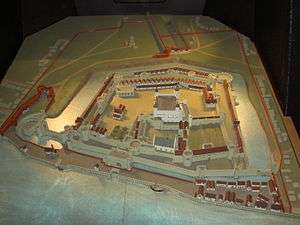
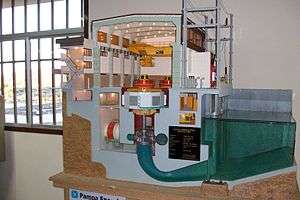
Scale models are used in many fields including engineering, architecture, film making, military command, salesmanship, and hobby model building. While each field may use a scale model for a different purpose, all scale models are based on the same principles and must meet the same general requirements to be functional. The detail requirements vary depending on the needs of the modeler.
To be a true scale model, all relevant aspects must be accurately modeled, such as material properties, so the model's interaction with the outside world is reliably related to the original object's interaction with the real world.
Requirements
In general a scale model must be designed and built primarily considering similitude theory. However, other requirements concerning practical issues must also be considered.
Similitude requirements
Similitude is the theory and art of predicting prototype (original object) performance from scale model observations.[1] The main requirement of similitude is all dimensionless quantities must be equal for both the scaled model and the prototype under the conditions the modeler desires to make observations. Dimensionless quantities are generally referred to as Pi terms, or π terms. In many fields the π terms are well established. For example, in fluid dynamics, a well known dimensionless number called the Reynolds number comes up frequently in scale model tests with fluid in motion relative to a stationary surface.[2] Thus, for a scale model test to be reliable, the Reynolds number, as well as all other important dimensionless quantities, must be equal for both scale model and prototype under the conditions that the modeler wants to observe.
An example of the Reynolds number and its use in similitude theory satisfaction can be observed in the scale model testing of fluid flow in a horizontal pipe. The Reynolds number for the scale model pipe must be equal to the Reynolds number of the prototype pipe for the flow measurements of the scale model to correspond to the prototype in a meaningful way. This can be written mathematically, with the subscript m referring to the scale model and subscript p referring to the prototype, as follows:
where
- is the mean velocity of the object relative to the fluid (SI units: m/s)
- is a characteristic linear dimension, (travelled length of the fluid; hydraulic diameter when dealing with river systems) (m)
- is the dynamic viscosity of the fluid (Pa·s or N·s/m² or kg/(m·s))
- is the density of the fluid (kg/m³).
Observing the equation above it is clear to see that while the Reynolds numbers must be equal for the scale model and the prototype, this can be accomplished in many different ways, for example, in this problem by altering the scale of the dynamic viscosity of the model to work with the scale of the length. This means, the scales of different quantities, for example a material's elasticity in the scale model versus the prototype, are governed by equating the dimensionless quantities and the other quantity's scaling within the dimensionless quantity to ensure the dimensionless quantity of interest is of equal magnitude for the scale model and prototype.
Scaling
With the above understanding of similitude requirements, it becomes clear the scale often reported in scale models refers only to the geometric scale, (L referring to length), and not the scale of the parameters potentially important to consider in the scale model design and fabrication. In general the scale of any quantity i, perhaps material density or viscosity, is defined as:
where
- is the quantity value of the prototype
- is the quantity value of the scale model
This relationship must be applied to all quantities of interest in the prototype, observing similitude requirements—so the scale model can be built using dimensions and materials that make scale model testing results meaningful with respect to the prototype.[3] One method to determine the dimensionless quantities of concern for a given problem is to use dimensional analysis.
Practical requirements
Practical concerns include the cost to construct the model, available test facilities to condition and observe the model, the availability of certain materials, and even who will build it. Practical requirements are often very diverse depending on the purpose of the scale model and they all must be considered to have a successful scale model experience.
As an example, perhaps an aerospace company needs to test a new wing shape. According to the similitude requirements the test must be carried out in a wind tunnel that can drop the temperature of the air to −128 °C (−198 °F), such as the 0.3-meter (12 in) Transonic Cryogenic Tunnel at NASA Langley Research Center.[4] However, if a facility such as this one can't be used, perhaps due to cost constraints, the similitude requirements must be relaxed or the test redesigned to accommodate the limitation.
Classes
For a scale model to represent a prototype in a perfectly true manner, all the dimensionless quantities, or π terms, must be equal for the scale model during the observational period and the prototype under the conditions the modeler desires to study. However, in many situations, designing a scale model that equates all the π terms to the prototype is simply not possible due to lack of materials, cost restrictions, or limitations of testing facilities. In this case, concessions must be made for practical reasons to the similitude requirements.
Depending on the phenomena being observed, perhaps some dimensionless quantities aren't of interest and thus can be ignored by the modeler and the results of the scale model can still safely be assumed to correspond to the prototype. An example of this from fluid dynamics is flow of a liquid in a horizontal pipe. Possible π terms to consider in this situation are Reynolds number, Weber number, Froude number, and Mach number. For this flow configuration, however, no surface tension is involved, so the Weber number is inappropriate. Also, compression of the fluid is not applicable, so the Mach number can be disregarded. Finally, gravity is not responsible for the flow, so the Froude number can also be disregarded. This leaves the modeler with only the Reynolds number to worry about in terms of equating its values for the scale model and the prototype.[5]
In general, scale models can be classified into three classes depending on the degree of similitude satisfaction they exhibit. To begin, a true model is one with complete similitude—that is, all π terms are equal for the scale model and the prototype. True models are difficult to realize in reality due to the many possible quantities the modeler must consider. As a result, modelers identify the important dimensionless quantities and construct a scale model that satisfies these. Important dimensionless quantities are called first-order dimensional requirements. A model that satisfies first-order similarity is called an adequate model. Finally, for scale models that fail to satisfy one or more of the first-order requirements, the name distorted model is given.[6]
Examples
Scale models are used by many fields for many different purposes. Some of the specific uses of scale models by specific fields are explained below in the examples.
Structural
Although structural engineering has been a field of study for thousands of years and many of the great problems have been solved using analytical and numerical techniques, many problems are still too complicated to understand in an analytical manner or the current numerical techniques lack real world confirmation. When this is the case, for example a complicated reinforced concrete beam-column-slab interaction problem, scale models can be constructed observing the requirements of similitude to study the problem. Many structural labs exist to test these structural scale models such as the Newmark Civil Engineering Laboratory at the University of Illinois, UC.[8]
For structural engineering scale models, it is important for several specific quantities to be scaled according to the theory of similitude. These quantities can be broadly grouped into three categories: loading, geometry, and material properties. A good reference for considering scales for a structural scale model under static loading conditions in the elastic regime is presented in Table 2.2 of the book Structural Modeling and Experimental Techniques.[9]
Structural engineering scale models can use different approaches to satisfy the similitude requirements of scale model fabrication and testing. A practical introduction to scale model design and testing is discussed in the paper "Pseudodynamic Testing of Scaled Models".[10]
Aircraft
Model aircraft are divided into two main groups: static and flying models.
Static
Static model aircraft are commonly built using plastic, but wood, metal, card and paper can also be used. Models are sold painted and assembled, painted but not assembled (snap-fit), or unpainted and not assembled. The most popular types of aircraft to model are commercial airliners and military aircraft. Aircraft can be modeled in many "scales". The scale notation is the size of the model compared to the real, full-size aircraft called the "prototype". 1:8 scale will be used as an example; it is read as: "1 inch (or whatever measurement) on the model is equal (: means equal) to 8 inches on the real (prototype) airplane". Sometimes the scale notation is not used; it is simply stated: "my model is one eighth (1/8) scale", meaning "my model is one eighth the size of the real airplane" or "my model is one eight as large as the real airplane". Popular scales are, in order of size, 1:144, 1:72 (the most numerous), 1:48, 1:32, 1:24, 1:16, 1:8 and 1:4. Some European models are available at more metric scales such as 1:50. The highest quality models are made from injection-molded plastic or cast resin. Models made from Vacuum formed plastic are generally for the more skilled builder. More inexpensive models are made from heavy paper or card stock. Ready-made die-cast metal models are also very popular. As well as the traditional scales, die-cast models are available in 1:200, 1:250, 1:350, 1:400, 1:500 and 1:600 scale.
These scales are usually reserved for civil airliners. Static aircraft scale modeling falls broadly into three categories: kit assembly, scratch-building, and collection of ready-made models. Scratch-builders tend to be the top echelon in terms of skill and craftsmanship. They tend to be the most discerning when it comes to accuracy and detail and they spend far more time on far fewer models than a kit assembler.
Kit assemblers fall roughly into two categories: OOB (Out of box) and modified. Out of Box refers to the act of assembling a kit only from what is contained in the box supplied, whereas a Modifier employs after-market products such as alternative decals, photo-etched metal detail parts, and cast resin detail or conversion parts to enhance or change the model in some way. Collectors are concerned purely with the issue of theme, and are not really interested in personal construction as such.
Aircraft modelers often fall into more than one category, as fancy takes them. The overwhelming majority of aircraft modelers concern themselves with depiction of real-life aircraft, but there is a smaller cadre of modelers who derive additional fun by 'bending' history a little by making models of aircraft that either never actually flew or existed, or by painting them in a color scheme that did not actually exist. This is commonly referred to as 'What-if' or 'Alternative' modeling, and the most common theme is 'Luftwaffe 1946' or 'Luftwaffe '46'. This theme stems from the idea of modeling German secret projects that never saw the light of day due to the close of World War II. This concept has been extended to include British, Russian, and US experimental projects that never made it into production.
Flying
Flying model aircraft are of two types: those constructed for aerodynamic research and those for recreation or aeromodeling.
Aerodynamic models may be constructed for use in a wind tunnel or in free flight. Small-scale piloted aircraft are even constructed to test some aspect of a proposed full-size design, but these are not considered as models even though they may be accurate to scale.
Recreational models are often made to resemble some real type. However the aerodynamic requirements of a small model are different from those of a full-size craft, so flying models are seldom fully accurate to scale. Most flying model aircraft can be placed in one of three groups: free flight, control line and radio controlled. Flying models can be built from scratch or from kits. Some kits take many hours to put together and some kits are almost ready to fly or ready to fly.
Plans-relief
With elements similar to miniature wargaming, building models and architectural models, a plan-relief is a means of geographical representation in relief as a scale model for military use, to visualise building projects on fortifications or campaigns involving fortifications.
Buildings
Most hobbyists who build models of buildings do so as part of a diorama to enhance their other models, such as a model railroad or model war machines. As a stand-alone hobby, building models are probably most popular among enthusiasts of construction toys such as Erector, Lego and K'Nex. Famous landmarks such as the Empire State Building, Big Ben and the White House are common subjects. Standard scales have not emerged in this hobby. Model railroaders use railroad scales for their buildings: HO scale (1:87), OO scale (1:76), N scale (1:160), and O scale (1:43). Lego builders use miniland scale (1:20) and minifig scale (1:48) and micro scale (1:192)[note 1] Generally, the larger the building, the smaller the scale. Model buildings are commonly made from plastic, foam, balsa wood or paper. Card models are published in the form of a book, and some models are manufactured like 3-D puzzles. Professionally, building models are used by architects and salesmen.
Architectural
Architecture firms usually employ model makers or contract model making firms to make models of projects to sell their designs to builders and investors. These models are traditionally hand-made, but advances in technology have turned the industry into a very high tech process than can involve Class IV laser cutters, five-axis CNC machines as well as rapid prototyping or 3D printing. Typical scales are 1:12, 1:24, 1:48, 1:50, 1:100, 1:200, 1:500, etc.
House portrait
Typically found in 1:50 scale and also called model house, model home or display house, this type of model is usually found in stately homes or specially designed houses. Sometimes this kind of model is commissioned to mark a special date like an anniversary or the completion of the architecture, or these models might be used by salesmen selling homes in a new neighborhood.
Buses and trucks
Typically found in 1:50 scale, most manufacturers of commercial vehicles and heavy equipment commission scale models made of die-cast metal as promotional items to give to prospective customers. These are also popular children's toys and collectibles. The major manufacturers of these items are Conrad and NZG in Germany. Corgi also makes some 1:50 models, as well as Dutch maker Tekno.
Trucks are also found as diecast models in 1:43 scale and injection moulded kits (and children's toys) in 1:24 scale. Recently some manufacturers have appeared in 1:64 scale like Code 3.

Cars
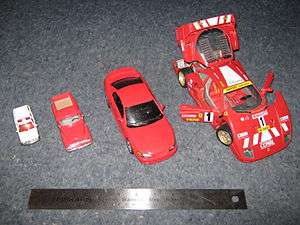
Although the British scale for 0 gauge was first used for model cars made of rectilinear and circular parts, it was the origin of the European scale for cast or injection moulded model cars. MOROP's specification of 1:45 scale for European 0 does not alter the series of cars in 1:43 scale, as it has the widest distribution in the world.
In America, a series of cars was developed from at first cast metal and later styrene models ("promos") offered at new-car dealerships to drum up interest. The firm Monogram, and later Tamiya, first produced them in a scale derived from the Architect's scale: 1:24 scale, while the firms AMT, Jo-Han, and Revell chose the scale of 1:25. Monogram later switched to this scale after the firm was purchased by Revell. Some cars are also made in 1:32 scale, and rolling toys are often made on the scale 1:64 scale. Chinese die-cast manufacturers have introduced 1/72 scale into their range. The smaller scales are usually die-cast cars and not the in the class as model cars. Except in rare occasions, Johnny Lightning and Ertl-made die-cast cars were sold as kits for buyers to assemble. Model cars are also used in car design.
Construction vehicles
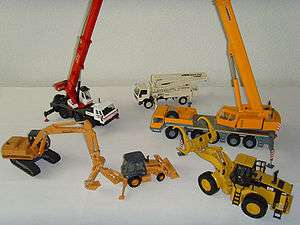
A model construction vehicle (or engineering vehicle) is a scale model or die-cast toy that represents a construction vehicle such as a bulldozer, excavator, crane, concrete pump, backhoe, etc.
Construction vehicle models are almost always made in 1:50 scale, particularly because the cranes at this scale are often three to four feet tall when extended and larger scales would be unsuited for display on a desk or table. These models are popular as children's toys in Germany. In the US they are commonly sold as promotional models for new construction equipment, commissioned by the manufacturer of the prototype real-world equipment. The major manufacturers in Germany are Conrad and NZG, with some competition from Chinese firms that have been entering the market.
Railways
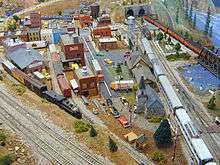
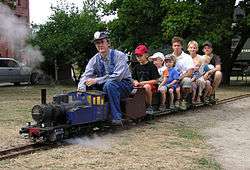
Model trains come in a variety of scales, from 1:8 on the large end and 1:450 (T scale) on the small. Each scale has its own strengths and weaknesses, and fills a different niche in the hobby. The largest models are as much as 3 meters (9.8 ft) long, the smallest a few centimeters. The most popular size is HO scale (1:87) and second is N scale (1:160).
Model railways originally used the term gauge, which refers to the distance between the rails, just as full-size railways do. Although model railways were also built to different gauges, "standard gauge" in 1:1 scale railroads is 4' 8.5". Therefore, a model railway reduces that standard to scale. An HO scale model railway would have track that is 1/87 of 4' 8.5", or about 0.65" from rail to rail. Now it is more typical to refer to the scale of the model, and the term scale has replaced "gauge" in most usages. This is despite considerable confusion between countries as to the definition of 0 scale and N scale.
Considerable confusion often arises when referring to "scale" and "gauge", especially as the words are sometimes used interchangeably. The word "scale" refers to the proportional size of the model; the word "gauge" applies to the measurement between the inside faces of the rails. To highlight this difference, consider the various gauges used in HO scale; A gauge of 16.5 mm is used to represent the "standard gauge" of 4 ft 8 1⁄2 in (1,435 mm) (HO scale), a gauge of 12 mm is used to represent 1,000 mm (3 ft 3 3⁄8 in) gauge (HOm) and the 3 ft 6 in (1,067 mm) gauge (HOn3-1/2) and a gauge of 9 mm is used to represent a prototype gauge of 2 ft (610 mm). It is completely incorrect to refer to the mainstream scales as "HO gauge", "N gauge" or "Z gauge"
The most popular scale to go with a given gauge was often derived at by the following roundabout process. German artisans would take strips of metal of standard metric size to make things to blueprints whose dimensions were in inches: hence "4 mm to the foot" yields the 1:76.2 size of the "OO scale". This British scale is anomalously used on the standard HO/OO scale (16.5 mm gauge from 3.5 mm/foot scale) tracks, however, because early electric motors weren't available commercially in smaller sizes.
There are three different standards for the "O" scale, each of which uses tracks of 32 mm for the standard gauge. The American version continues a dollhouse scale of 1:48. It is sometimes called "quarter-gauge", as in "one-quarter-inch to the foot". The British version continued the pattern of sub-contracting to Germans; so, at 7 mm to the foot, it works out to a scale of 1:43.5. Later, MOROP, the European authority of model railroad firms, declared that the "O" gauge (still 32 mm) must use the scale of 1:45. That is, in Europe the below-chassis dimensions must be slightly towards 4 feet 6 inches, to allow wheel/tyre/splasher clearance for smaller than realistic curved sections.
"Live steam" railways, that people actually ride on, are built in many scales, such as 1-1/2", 1", and 3/4 inches to the foot. Common gauges are 7-1/2" (Western US) and 7-1/4" (Eastern US & rest of the world), 5", 4-3/4". Smaller live steam gauges do exist, but as the scale gets smaller, pulling power decreases. One of the smallest gauges on which a live steam engine can pull a passenger is the now almost defunct 2-1/2-inch gauge.
Robots
Japanese firms have marketed toys and models of what are often called mecha, nimble humanoid fighting robots. The robots, which appear in animated shows (anime), are often depicted at a size between 15-20m in height, and so scales of 1:100 and 1:144 are common for these subjects, though other scales such as 1:72 are commonly used for robots and related subjects of different size.
The most prolific manufacturer of mecha models is Bandai, whose Gundam kit lines were a strong influence in the genre in the 1980s. Even today, Gundam kits are the most numerous in the mecha modeling genre, usually with dozens of new releases every year. The features of modern Gundam kits, such as color molding and snap-fit construction, have become the standard expectations for other mecha model kits.
Due to the fantasy nature of most anime robots, and the necessary simplicity of cel-animated designs, mecha models lend themselves well to stylized work, improvisations, and simple scratchbuilds. One of Gundam's contributions to the genre was the use of a gritty wartime backstory as a part of the fantasy, and so it is almost equally fashionable to build the robots in a weathered, beaten style, as would often be expected for AFV kits as to build them in a more stylish, pristine manner.
Rockets and spacecraft
Model rocket kits began as a development of model aircraft kits, yet the scale of 1:72 [V.close to 4 mm.::1foot] never caught on. Scales 1:48 and 1:96 are used. There are some rockets of scales 1:128, 1:144, and 1:200, but Russian firms put their large rockets in 1:288. Heller SA offers some models in the scale of 1:125.
Science fiction space ships are heavily popular in the modeling community. Models based on ships from such franchises as Star Trek, Star Wars, and Battlestar Galactica are regularly sold and created in scales ranging from 1:24 for fighters and smaller ships to 1:1000, 1:1400, and 1:2500 for most main franchise ships, and up to 1:10000 for the larger Star Wars ships (for especially objects like the Death Stars and Super Star Destroyers, even smaller scales are used). Finemolds in Japan have recently released a series of high quality injection molded Star Wars kits in 1:72, and this range is supplemented by resin kits from Fantastic Plastic.
Living creatures
Scale models of people and animals are found in a wide variety of venues, and may be either single-piece objects or kits that must be assembled, usually depending on the purpose of the model. For instance, models of people as well as both domestic and wild animals are often produced for display in model cities or railroads to provide a measure of detail or realism, and scaled relative to the trains, buildings, and other accessories of a certain line of models. If a line of trains or buildings does not feature models of living creatures, those who build the models often buy these items separately from another line so they can feature people or animals. In other cases, scale model lines feature living creatures exclusively, often focusing on educational interests.
Models of living creatures requiring assembly are not as common as single-piece units, but certainly not unheard of. One of the most prolific kinds of kits requiring assembly that feature living creatures are models of human and animal skeletons. Like their single-piece counterparts, such kits are often touted as being educational activities. Skeleton kits often have unique features such as glow-in-the-dark pieces or attachable internal organs. Again, dinosaurs are a popular subject for such models. There are also garage kits, which are often figures of anime characters in multiple parts that require assembly.
Ships and naval war-gaming
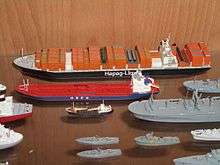
.jpg)
In the first half of the 20th century, navies used hand-made models of warships for identification and instruction in a variety of scales. That of 1:500 was called "teacher scale." Besides models made in 1:1200 and 1:2400 scales, there were also ones made to 1:2000 and 1:5000. Some, made in Britain, were labelled "1 inch to 110 feet", which would be 1:1320 scale, but aren't necessarily accurate.
Michele Morciano says small scale ship models were produced in about 1905 linked to the wargaming rules and other publications of Fred T. Jane. The company that standardised on 1:1200 was Bassett-Lowke in 1908. The British Admiralty subsequently contracted with Bassett-Lowke and other companies and individual craftsmen to produce large numbers of recognition models, to this scale, in 1914–18.[11]
Just before the Second World War, the American naval historian (and science fiction author) Fletcher Pratt published a book on naval wargaming as could be done by civilians using ship models cut off at the waterline to be moved on the floors of basketball courts and similar locales. The scale he used was non-standard (reported as 1:666), and may have been influenced by toy ships then available, but as the hobby progressed, and other rule sets came into use, it was progressively supplemented by the series 1:600, 1:1200, and 1:2400. In Britain, 1:3000 became popular and these models also have come into use in the USA. These had the advantage of approximating the nautical mile as 120 inches, 60 inches, and 30 inches, respectively. As the knot is based on this mile and a 60-minute hour, this was quite handy.
After the war, firms emerged to produce models from the same white metal used to make toy soldiers. Lines Bros. Ltd, a British firm, offered a tremendously wide range of waterline merchant and naval ships as well as dockyard equipment in the scale 1:1200 which were die-cast in Zamak. In the US, at least one manufacturer, of the wartime 1:1200 recognition models, Comet, made them available for the civilian market postwar, which also drove the change to this scale. In addition, continental European manufacturers and European ship book publishers had adopted the 1:1250 drawing scale because of its similar convenience in size for both models and comparison drawings in books.
A prestige scale for boats, comparable to that of 1:32 for fighter planes, is 1:72, producing huge models, but there are very few kits marketed in this scale. There are now several clubs around the world for those who choose to scratch-build radio-controlled model ships and submarines in 1:72, which is often done because of the compatibility with naval aircraft kits. For the smaller ships, plank-on-frame or other wood construction kits are offered in the traditional shipyard scales of 1:96, 1:108, or 1:192 (half of 1:96). In injection-molded plastic kits, Airfix makes full-hull models in the scale the Royal Navy has used to compare the relative sizes of ships: 1:600. Revell makes some kits to half the scale of the US Army standard: 1:570. Some American and foreign firms have made models in a proportion from the Engineer's scale: "one-sixtieth-of-an-inch-to-the-foot", or 1:720.
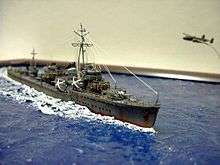
Manned ships
Many research workers, hydraulics specialists and engineers have used scale models for over a century, in particular in towing tanks. Manned models are small scale models that can carry and be handled by at least one person on an open expanse of water. They must behave just like real ships, giving the shiphandler the same sensations. Physical conditions such as wind, currents, waves, water depths, channels, and berths must be reproduced realistically.
Manned models are used for research (e.g. ship behaviour), engineering (e.g. port layout) and for training in shiphandling (e.g. maritime pilots, masters and officers). They are usually at 1:25 scale.
Tanks and wargaming
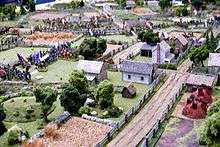
Just before the 20th century, the British historian and science fiction author H. G. Wells published a book, Little Wars, on how to play at battles in miniature. His books use 54 mm lead figures, particularly those manufactured by Britains. His fighting system employed spring-loaded model guns that shot matchsticks.
This use of physical mechanisms was echoed in the later games of Fred Jane, whose rules required throwing darts at ship silhouettes; his collection of data on the world's fleets was later published and became renowned. Dice have largely replaced this toy mayhem for consumers.
For over a century, toy soldiers were made of white metal, a lead-based alloy, often in architect's scale-based ratios in the English-speaking countries, and called tin soldiers. After the Second World War, such toys were on the market for children but now made of a safe plastic softer than styrene. American children called these "army men". Many sets were made in the new scale of 1:40. A few styrene model kits of land equipment were offered in this and in 1:48 and 1:32 scales. However, these were swept away by the number of kits in the scale of 1:35.
Those who continued to develop miniature wargaming preferred smaller scale models, the soldiers still made of soft plastic. Airfix particularly wanted people to buy 1:76 scale soldiers and tanks to go with "00" gauge train equipment. Roco offered 1:87 scale styrene military vehicles to go with "HO" gauge model houses. However, although there is no 1:72 scale model railroad, more toy soldiers are now offered in this scale because it is the same as the popular aircraft scale. The number of fighting vehicles in this scale is also increasing, although the number of auxiliary vehicles available is far fewer than in 1:87 scale.
A more recent development, especially in wargaming of land battles, is 15 mm white metal miniatures, often referred to as 1:100. The use of 15 mm scale metals has grown quickly since the early 1990s as they allow a more affordable option over 28 mm if large battles are to be refought, or a large number of vehicles represented. The rapid rise in the detail and quality of castings at 15 mm scale has also helped to fuel their uptake by the wargaming community.
Armies use smaller scales still. The US Army specifies models of the scale 1:285 for its sand table wargaming. There are metal ground vehicles and helicopters in this scale, which is a near "one-quarter-inch-to-six-feet" scale. The continental powers of NATO have developed the similar scale of 1:300, even though metric standardizers really don't like any divisors other than factors of 10, 5, and 2, so maps are not commonly offered in Europe in scales with a "3" in the denominator.
Consumer wargaming has since expanded into fantasy realms, employing scales large enough to be painted in imaginative detail - so called "heroic" 28 mm figures, (roughly 1:64, or S scale). Firms that produce these make small production lots of white metal.
Alternatively to the commercial models, some modelers also tend to use scraps to achieve home-made warfare models. While it doesn't always involve wargaming, some modelers insert realistic procedures, enabling a certain realism such as firing guns or shell deflection on small scale models.
Engines
Kits for building an engine model are available, especially for kids. The most popular are the internal combustion, steam, jet, and Stirling model engine. Usually they move using an electric motor or a hand crank, and many of them have a transparent case to show the internal process in action.
Miniatures in contemporary art
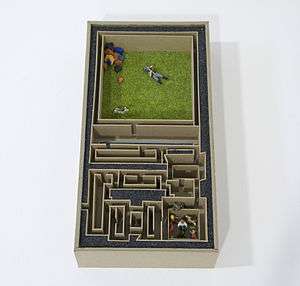
Miniatures and model kits are used in contemporary art whereby artists use both scratch built miniaturizations or commercially manufactured model kits to construct a dialogue between object and viewer. The role of the artist in this type of miniature is not necessarily to re-create an historical event or achieve naturalist realism, but rather to use scale as a mode of articulation in generating conceptual or theoretical exploration. Political, conceptual, and architectural examples are provided by noted artists such as Bodys Isek Kingelez, Jake and Dinos Chapman (otherwise known as the Chapman Brothers), Ricky Swallow, Shaun Wilson, Sven Christoffersen, or the Psikhelekedana artists from Mozambique, James Casebere, Oliver Boberg, and Daniel Dorall.
See also
- Autofest City
- Computer-aided design
- Cutaway drawing
- Die-cast toy
- Historical Miniatures Gaming Society
- International Plastic Modellers' Society
- Maquette
- Miniature effect
- Miniature faking
- Miniature figure (disambiguation)
- Miniature park
- Miniature pioneering
- Plastic model
- Rail transport modelling scale standards
- Solar system model
- Standard gauge in model railways
- Similitude (model)
- Terrain model
- List of scale model sizes
- List of scale-model industry people
- List of scale model kit manufacturers
Notes
- Crowe, C., et al. 2010, p. 259
- Crowe, C., et al. 2010, p. 262
- Harris, H., et al. 1999, p. 57
- "Archived copy". Archived from the original on 2013-12-02. Retrieved 2013-11-19.CS1 maint: archived copy as title (link)
- Crowe, C., et al. 2010, p. 263
- Harris, H., et al. 1999, p. 56
- http://ceephotos.karcor.com/?s=load+and+confinement+box
- "Archived copy". Archived from the original on 2013-10-20. Retrieved 2013-11-19.CS1 maint: archived copy as title (link)
- Harris, H., et al. 1999, p. 62
- Kumar, et al. 1997, p. 1
- Morciano, Michele (2003). Classic Waterline Ship Models in the 1:1200/1250 scale. Rome: self published. p. 5.
- In the Lego community, micro scale can refer to anything smaller than minifig scale (1:48), but 1:192 is occasionally set as a standard micro scale. This ratio is arrived at by scaling a person (6 feet) to the height of a Lego brick (3/8 inches). See Bedford, Alan (2005). The Unofficial LEGO Builder's Guide. No Starch Press.
References
- Crowe, Clayton t.; Elger, Donald F.; Williams, Barbara C.; Roberson, John A. (2010). Engineering Fluid Mechanics. John Wiley & Sons, Inc. ISBN 978-0-470-40943-5.
- Harris, Harry G.; Sagnis, Gajanan M. (1999). Structural Modeling and Experimental Techniques. CRC Press LLC. ISBN 9780849324697.
- Kumar; et al. (1997). "Pseudodynamic Testing of Scaled Models". J. Struct. Eng. 123 (4): 524–526.
Further reading
- Crowe, Clayton t.; Elger, Donald F.; Williams, Barbara C.; Roberson, John A. (2010). Engineering Fluid Mechanics. John Wiley & Sons, Inc. ISBN 978-0-470-40943-5.
- Harris, Harry G.; Sagnis, Gajanan M. (1999). Structural Modeling and Experimental Techniques. CRC Press LLC. ISBN 9780849324697.
- Lune, Peter van. "FROG Penguin plastic scale model kits 1936 - 1950". Zwolle, The Netherlands, 2017, published by author ISBN 978-90-9030180-8